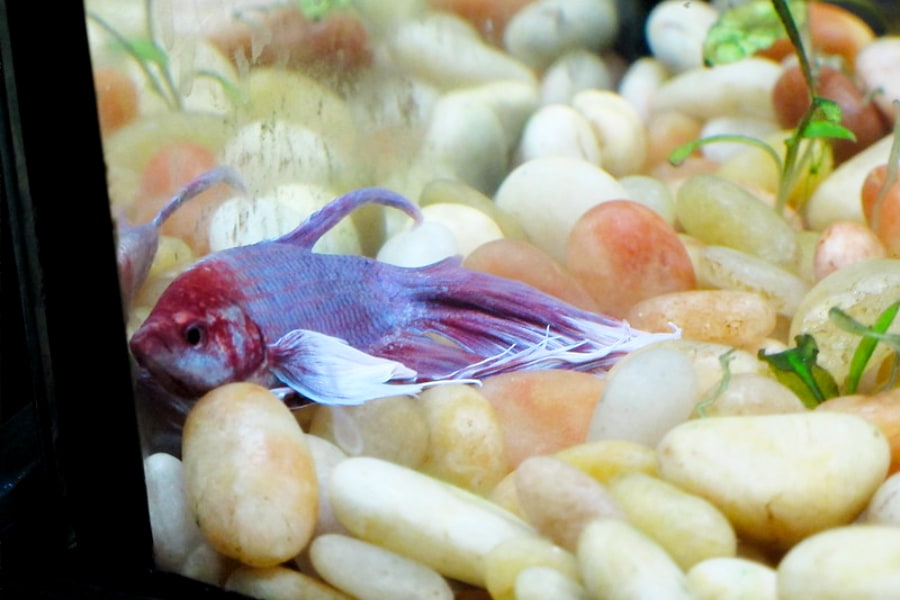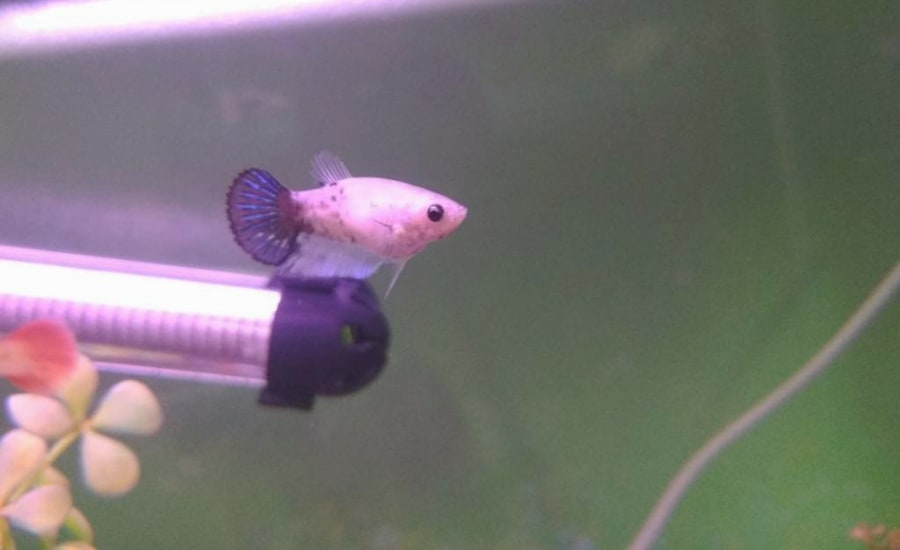Caring for Betta fish is fun until your pet gets stressed for whatever reasons. When something goes wrong with your fish, you may see some signs like a bloated belly, stripes, and clamped fins.
Betta clamped fins may be caused by poor tank conditions but it may also be a symptom of a certain disease.
When Betta’s fins get clamped, you will find it look like sticking together. With such condition, a fish may have trouble swimming straight and it can be worse if left untreated.
When this happens, you won’t see attractive fins usually displayed by Betta fish.
Furthermore, stressed fish with clamped fins might show other symptoms like change in color, lack of appetite, and lethargy.
Are you new to Betta caring? Read on and get to know more about clamped fins in Betta fish and how to treat them.
What Are Clamped Fins?
Clamped fins are often confused with fin rot. Both affect Betta’s fins but actually, they are two different conditions that require different treatment.
While fin rot is mostly caused by fungal or bacterial infection, clamped fins are often triggered by stress.
When a Betta fish has clamped fins, you will see the fluttering fins clamp up and curled—it looks like the fins are dipped in oil.
Of course, Betta with clamped fins look unattractive, not to mention the fins that stick together cause swimming problems that can get worse over time.
Causes of Clamped Fins in Betta Fish
There are so many reasons that cause clamped fins in Betta fish. Your ability to diagnose the reason allows you to take the best treatment, allowing faster and better recovery of your pet.
It is important to note that clamped fins are not a sign of a specific problem. This condition may appear because of several problems, so it is important to figure out potential causes of clamped fins in your Bettas.
1. Poor Water Quality
This is the most common reason for curled fins in Betta fish. Providing clean water and a proper tank is essential to make sure your Bettas grow healthy and happy in their tank.
Not only should you inspect the filtration system, but it is also important to change the water regularly.
Many cases of clamped fins are caused by a broken filtration system that prevents the tank from cleaning itself. Irregular water changes are also the main cause of poor water quality that makes your fish stressed.
2. Stress
Quite renowned among Betta hobbyists, stress can decrease the lifespan of Bettas.
This kind of fish typically requires low maintenance, but still, they might get stressed out for reasons, including small tanks, dirty water, and incompatible mates. A high level of ammonia also causes stress in the fish.
3. Parasites
Quite similar to fin rot, clamped fish can be a sign of infections. A tank mate may bring a contagious parasite that passes to the Betta, causing an infection that makes the fins clamped or curled.
Besides, it may be a symptom of bacterial and fungal infections.
Interestingly, fights may be another reason for clamped fins. Bettas are aggressive and they pick fights with others. Injuries from other’s attacks may cause their fins to get curled or disfigured.
4. Old Age
Age affects the appearance of your Bettas. As they get older, their body deteriorates and their fins naturally curl up.
Betta fish can live up to four years and it is quite normal to find their fins curl up when they approach this age. But, please note that some Bettas may live up to 10 years under proper circumstances.
In addition to old age, genetics also play a role in causing clamped fins. When Betta parents have clamped fins, chances are that their Betta babies have a similar condition and it cannot be cured.
How to Treat Clamped Fins

Despite the unattractive visual, clamped fins in Betta can be treated. There are different solutions behind each cause, so you might want to take a closer look at the different treatment methods below.
Test Water Parameters
Testing the water parameter is a must, not only because your Betta has clamped fins. Regular testing every week helps make sure if your tank environment is in the best condition.
It also helps you figure out if changes happen in parameters, causing problems in Betta fish.
What should be checked? When testing water parameters, you need to check the ammonia, pH, nitrate, and nitrite.
When you find something wrong, quickly take an action to get everything back to normal. It can be adjusting the heater or changing the water.
Add More Places to Hide
Your Bettas might be stressed out because of incompatible tank mates. If this is the main reason for clamped fins, it is best to add more hiding places in your tank.
Opt for plants or caves for the easiest choice, but you can also grab some decoration or driftwood.
Hiding places not only become a safe place for your Bettas. Sometimes, decorations can interrupt your fish so they will be less likely to see other fish. It works well to help reduce stress.
Separate Tank
Do you find some fish is turning into bullies? The best solution is to remove bullies in a separate tank.
Alternatively, you can get a new tank for your Bettas and see how they enjoy it. Just make sure the new tank has all the requirements for keeping the fish.
Keep Feeding Your Fish
Stressed fish may show several signs, one of which is lack of appetite. However, it is important to keep feeding them to make sure they get enough nutrients.
You may reduce the portion—one or two pellets a time will be enough to help them with recovery.
What if your Bettas don’t eat pellets? Try dropping some daphnia or brine shrimp to the tank and see how your fish responds. Daphnia is one of their natural foods and it can trigger their instinct to eat.
Clamped Fins in Baby Betta

Clamped fins happen not only in adult Bettas. In some cases, baby Bettas may have clamped fins.
Overall, the reason could be similar to the ones that cause a similar condition in adults, such as poor water quality, stress, and infection. Water temperature and pH may also trigger clamped fins in baby Bettas.
Since baby fish is not as strong as adults, it becomes essential to take immediate action. Once you noticed clamped fins, do the treatment as listed above depending on the causes.
If you suspect poor water quality causes fins sticking together, then it is necessary to perform a water change to improve water quality.
In some cases, you may also find your Bettas with clamped fins are lethargic. This condition is commonly caused by cold water temperature.
Since Bettas are cold-blooded, the cold water temperature will slow down the function of their body.
When you find your fish is lethargic, immediately check water temperature and make an adjustment. But in other cases, lethargy can be caused by bacterial and parasite infection.
So, be sure to double-check the cause before getting the right treatment for your Betta fish.
Betta clamped fins sound horrible but there’s nothing to worry about.
With a little knowledge of the causes and treatment of curled fins, you can easily get through the problem and bring your bettas to their best condition. Get inspired and make difference.



